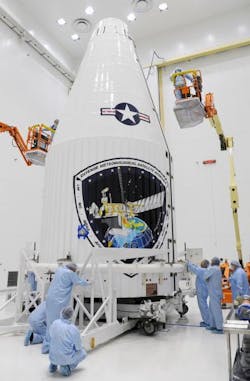Since the 1960s, the Defense Meteorological Satellite Program (DMSP) has helped collect data that enables military forecasters to find, track, and forecast weather systems globally to improve operations. The newest satellite in the fleet, DMSP-19, was recently encapsulated for its upcoming launch. It is equipped with an upgraded sensor suite that will help capture visible and infrared cloud cover. As a result, it will be able to study meteorological, oceanographic, and solar-geophysical information in all conditions.
The DMSP-19’s main sensor is the Special Sensor Microwave Imager (SSM/I). That imager provides all-weather capability for tactical operations and is especially useful in forecasting severe-storm activity. According to the National Snow & Ice Data Center, the SSM/I is “a seven-channel, four-frequency, orthogonally polarized, passive microwave radiometric system that measures atmospheric, ocean and terrain microwave brightness temperatures at 19.35, 22.2, 37.0, and 85.5 GHz.”
The instrument consists of an offset parabolic reflector that is fed by a corrugated, broadband, seven-port horn antenna. The absolute brightness of the scene is received by the antenna and then spatially filtered to produce an effective input signal of the feed horn. This data is used to note geophysical parameters, such as ocean surface, wind speed, precipitation over land, soil moisture, and land surface temperature.
Another on-board sensor, the Operational Linescan System, observes clouds via both visible and infrared imagery for worldwide forecasts. It scans areas 1800 miles wide and is capable of covering the entire earth in about 12 hours. All of these elements combine to track and forecast weather systems--focusing particularly on remote and hostile areas for deployed troops.
The DMSP-19’s April 2014 launch is the program’s first in five years, as DMSP-18 was launched in 2009. Over 40 satellites have been produced in the program’s history. DMSP is led by the U.S. Air Force Space and Missile Systems Center with controls provided by the National Oceanic and Atmospheric Administration. All DMSP satellites are integrated and tested at Lockheed Martin Space Systems’ facility in California.

